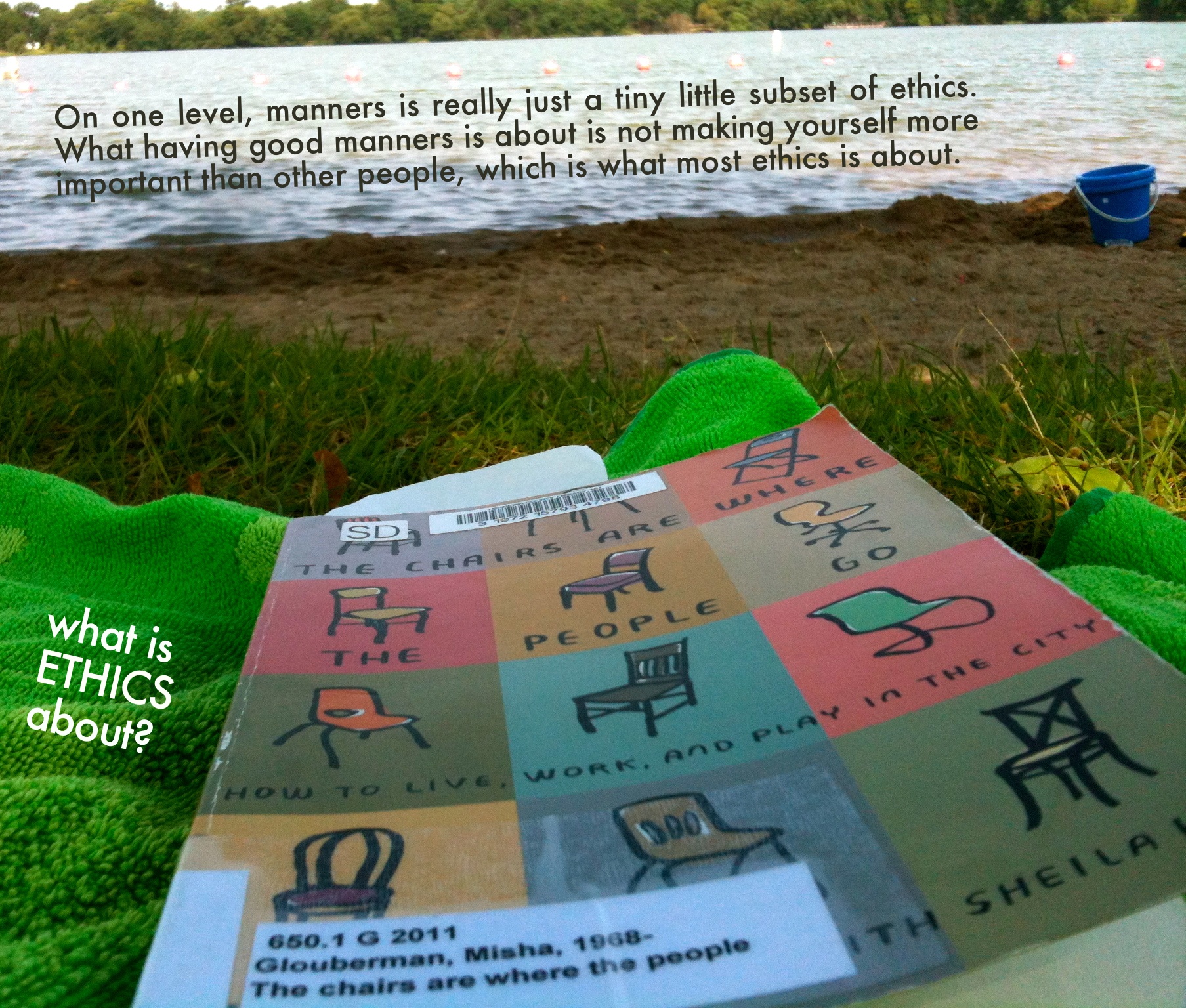About 6 weeks ago, while in the process of doing some research on the history and critiques of self-help books, I came across an interview with Sheila Heti. In the interview she discusses two of her recent books, The Chairs are Where the People Go and How Should a Person Be? I immediately put The Chairs on my Pinterest reading list–I’m not sure why I didn’t add How Should at the same time, but I remedied that by adding it to the list this morning–and about a month later, I requested it from the Minneapolis public library. A few days ago, I finally had a chance to read it while sitting at Lake Nokomis and the Highland Park pool. Here’s a picture that I took at Lake Nokomis, right after finishing one of the chapters on manners:
I really enjoyed reading this book! Such a great twist on the usual advice/self-help book (on the back, it is described as a “self-help book for people who feel they don’t need help”). It’s a collaboration between writer Sheila Heti and her friend, Misha Glouberman, in which Heti interviewed and then recorded (almost word for word) Glouberman’s thoughts on a wide range of topics that he cares most about. While Glouberman gives some advice on wide-ranging topics like, How to Make Friends in a New City (ch 2), How to be Good at Playing Charades (ch 5), Don’t Pretend There is No Leader (ch 6), Seeing your Parents Once a Week (ch 45) and Get Louder or Quit (ch 49), this book isn’t about advising you on how-to do anything in particular. Instead, it is about documenting one (very interesting and thoughtful) person’s ethos/approach to life. After reading (almost) all of the brief 1-2 page chapters, I feel that I have some sense of who Glouberman is–what he believes, what he does, what he cares about–and I feel inspired to both incorporate some of his ideas into my own ethos and to document some of my thoughts (and the thoughts of other interesting people) in a similar way.
As I was writing the line about this book not being about how-to do anything in the above paragraph, I began reflecting more on my own aversion to “how-to manuals.” I really don’t like giving advice to others, or telling them how exactly to do things (which sometimes gets me into trouble as a teacher, especially with students who expect demand that I give them explicit instructions/directions on how to do things). I like to help/encourage/inspire others by giving them tools to figure things out for themselves. Of course, this doesn’t always work; some people/students need more explicit guidance and strongly want to be told “this is how you do x.” I have a lot of difficulty fulfilling this need/want. Does that make me an ineffective (bad?) teacher or parent? I struggle with this question sometimes.
A few of Glouberman’s chapters really resonated with me. In chapter one–“People’s Protective Bubbles are Okay”–he talks about how people sometimes need to not be interacting with others. In response to those who view this non-interaction as a problem and who try to force people to interact in public spaces through public art projects, he says:
It’s necessary to screen people out. It would be overwhelming if you had to perceive every single person on a crowded subway car in the fullness of their humanity. It would be completely paralyzing. So don’t try to fix this. There is no problem.
Yes! As I read through this passage again I wonder, what does it mean to “perceive every single person in the fullness of their humanity”? And how does this differ (if, at all) from recognizing their humanity…or their right to be perceived as human? Also, what counts as interaction?
Another chapter I really enjoyed was #46, Asking a Good Question. This chapter focuses on the rules that Glouberman offers to people who wish to participate in the Q & A portion of his lectures. Here are a few that I’ve paraphrased: (Admittedly, I’m reluctant to paraphrase because I really like how he writes. However, for brevity’s sake, I’ve decided to condense/summarize here.)
1. A question has to be a question. You can’t turn a statement into a question by raising your voice at the end of your sentence. You’re not fooling anyone.
2. There are no two-part questions. They are 2 separate questions. Pick the best one and ask it.
3. Think about the feelings that motivate you to ask the question. Curiosity and anger are good motivators for effective/productive/engaging questions. Pride and a desire to look smart (or to make others look stupid/small) are not.
I love how he provides these rules for participants. It would be wonderful if all academic conference attendees were instructed in this way! His statements here make me want to come up with my own list of rules for asking a good question. Sounds like a great project for my staying in trouble tumblr!











